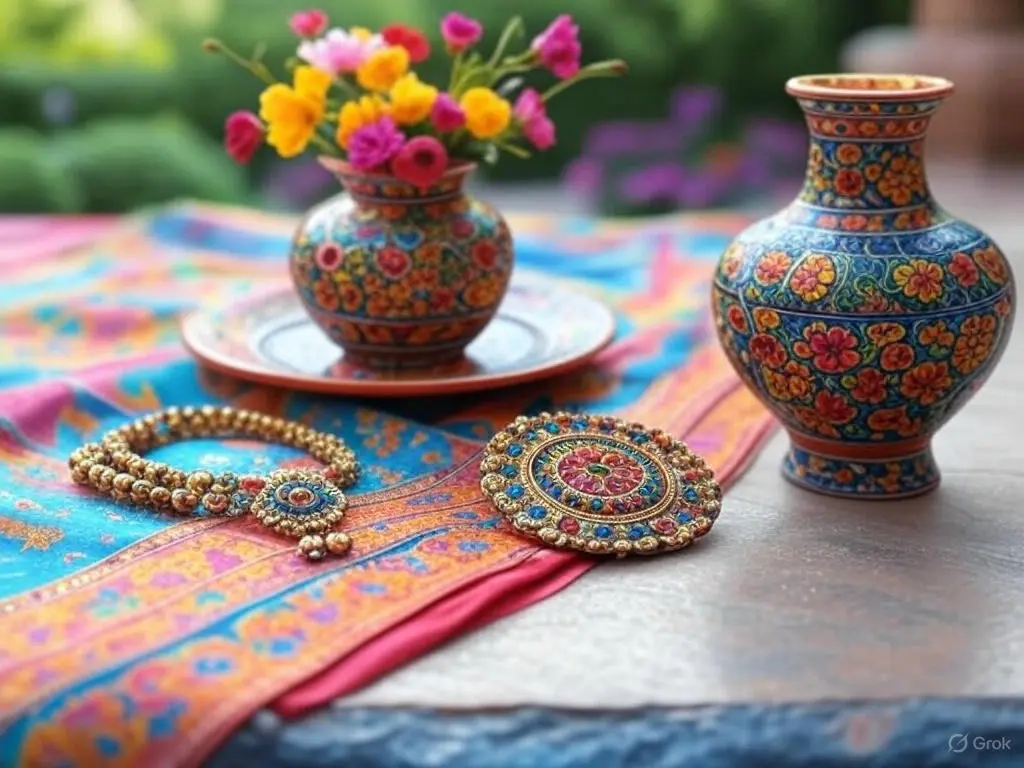
Minakari, often referred to as Meenakari, is a captivating art form that has enchanted admirers for centuries with its vivid colors and intricate patterns. The name “Minakari” stems from the word “Mina,” meaning heaven or paradise, a fitting description for the ethereal beauty of this craft. This ancient technique involves enameling metals and ceramics, transforming simple materials into breathtaking works of art. Artisans skillfully adorn copper, silver, or gold with vibrant enamels, crafting items ranging from delicate jewelry to ornate vases and plates. With roots stretching back to ancient times, Minakari has evolved across cultures, becoming a cherished symbol of tradition and craftsmanship.
In this article, we’ll journey through the world of Minakari, exploring its meaning, techniques, and applications in fashion and decor, including the unique Minakari Saree. We’ll also delve into the factors that influence Minakari prices and why this art continues to hold value today. Whether you’re drawn to the elegance of Persian Minakari or the vibrant allure of a Minakari plate, this exploration will reveal the magic of an art form that bridges the past and present. For those eager to discover more, platforms like AmeenShop offer a glimpse into authentic artisanal creations that embody the spirit of Minakari.
The essence of Minakari lies in its ability to transform everyday materials into objects of extraordinary beauty. The Minakari meaning is deeply poetic, derived from “Mina,” which evokes the idea of paradise, and “kari,” meaning work or craft. Together, they describe an art that brings a touch of heaven to earthly creations. Minakari art involves painting and coloring metal or ceramic surfaces with enamel, a process that results in durable, glossy designs that captivate the eye. This craft is celebrated for its intricate patterns, often featuring floral motifs, geometric shapes, and other traditional designs that reflect cultural heritage.
The origins of Minakari are steeped in history, with evidence of enameling techniques dating back to ancient civilizations. While its precise beginnings are debated, it’s widely recognized that Minakari flourished in regions where craftsmanship was highly valued. Over centuries, artisans refined the technique, passing down their knowledge through generations. Today, Persian Minakari is particularly renowned for its elegance, characterized by vibrant blues, greens, and reds that seem to glow with life.
Minakari is applied to a wide range of objects, from functional items like plates and vases to decorative pieces and jewelry. Each piece is a testament to the artisan’s skill, requiring patience and precision to achieve the perfect balance of color and form. The process begins with preparing the base material, typically a metal like copper, which is cleaned and shaped. Enamel, made from powdered glass and minerals, is then applied in layers, with each layer fired at high temperatures to fuse it to the surface. The result is a piece that not only dazzles but also carries the weight of centuries-old tradition.
The cultural significance of Minakari cannot be overstated. It’s more than just a decorative art; it’s a storytelling medium that preserves the values and aesthetics of the cultures that practice it. Whether it’s a Minakari vase gracing a home or a piece of jewelry worn on a special occasion, these creations connect us to a rich artistic legacy.
Creating Minakari art is a meticulous process that blends technical expertise with artistic vision. The primary materials include metals like copper, silver, or gold, and occasionally ceramics, which serve as the canvas for the enamel. The enamel itself is a mixture of quartz, borax, and other minerals, ground into a fine powder and mixed with water to form a paste. This paste is applied in precise patterns, bringing the artisan’s design to life.
The creation of a Minakari piece involves several key steps:
Base Preparation: The metal or ceramic surface is thoroughly cleaned and polished to ensure a smooth foundation.
Design Sketching: Artisans draw the intended pattern, often inspired by nature or traditional motifs like flowers or birds.
Enamel Application: Using brushes or spatulas, the enamel paste is carefully applied, sometimes in multiple layers to build depth.
Firing: The piece is fired in a kiln at 700–800°C, fusing the enamel to the base. This step requires precise temperature control to achieve vibrant colors.
Polishing: After firing, the piece is polished to enhance its shine and remove any imperfections.
Different styles of Minakari add variety to the craft. For instance, Mina Naghashi involves painting enamel directly onto the surface, creating a flat design. Barjast-e Mina features raised patterns filled with enamel for a three-dimensional effect, while Khaneh Bandi uses metal lines to separate colors, resembling stained glass. Each style showcases the versatility of Minakari art and the creativity of its practitioners.
The colors used in Minakari are a defining feature, ranging from deep blues and greens to bright reds and yellows. Achieving the perfect shade requires careful management of firing temperatures, as each color responds differently to heat. This technical challenge is part of what makes Minakari so remarkable—every piece is a delicate balance of science and art.
|
Minakari Type |
Description |
Common Applications |
|---|---|---|
|
Mina Naghashi |
Flat enamel painting on metal or ceramic |
Plates, vases, tiles |
|
Barjast-e Mina |
Raised designs filled with enamel |
Jewelry, decorative items |
|
Khaneh Bandi |
Compartmentalized colors with metal lines |
Ornaments, small decor |
This table highlights the diversity of Minakari techniques, each suited to different objects and aesthetic goals. Whether it’s a Minakari plate or a delicate pendant, the craftsmanship remains unparalleled.
Minakari’s allure extends into the world of fashion, where it adds a touch of elegance to both jewelry and textiles. Minakari jewelry is a standout, cherished for its vibrant colors and intricate designs. From necklaces and earrings to bangles and rings, these pieces often feature motifs like peacocks, flowers, or geometric patterns, symbolizing beauty and grace. The enamel is applied to metals like silver or gold, creating a striking contrast that catches the light and draws the eye. Minakari jewelry is a favorite for special occasions, such as weddings or festivals, where its rich aesthetic complements traditional attire.
Beyond jewelry, Minakari has inspired a unique textile tradition in the form of Minakari Sarees. These sarees, often woven in regions known for their textile heritage, use colorful silk threads to create patterns that echo the vibrant designs of Minakari art. Unlike traditional Minakari, which involves enamel on metal, Minakari Sarees are crafted through weaving techniques, sometimes incorporating metallic zari threads for added shimmer. The result is a garment that combines the richness of silk with the intricate beauty of enamel-inspired designs, making it a popular choice for celebrations.
The process of creating a Minakari Saree is a feat of skill. Weavers meticulously blend different colored threads to form motifs like paisleys, florals, or zigzag borders, all woven directly into the fabric. These sarees are not just clothing; they’re wearable art, embodying the same dedication to craftsmanship as a Minakari vase or plate. Their vibrant colors and luxurious texture make them a statement piece, perfect for those who value tradition and elegance.
Minakari’s influence in fashion highlights its versatility. Whether adorning a bride’s wrist or draping her in a shimmering saree, this art form brings a sense of heritage and artistry to modern wardrobes, ensuring its relevance in today’s world.
The value of Minakari lies not only in its beauty but also in the skill and history it represents. The Minakari price can vary significantly based on several factors:
Material: Pieces made with gold or silver are more costly than those using copper.
Design Complexity: Intricate patterns with multiple colors and layers require more time and expertise, increasing value.
Artisan Expertise: Works by master artisans or those with a long-standing reputation often command higher prices.
Rarity: Limited-edition or uniquely designed pieces are highly prized by collectors.
Hawkins.
Appreciating Minakari involves recognizing the craftsmanship behind each piece. Enthusiasts look for qualities like smooth enamel surfaces, vibrant color clarity, and precise designs. They also value the narrative behind each item, knowing it represents hours of dedicated work. A Minakari plate, for instance, might feature a floral motif that tells a story of cultural heritage, while a Minakari vase could showcase the artisan’s mastery of color and form.
In today’s globalized world, Minakari remains a cherished art form, with artisans exploring new ways to blend tradition with modern design. Platforms like AmeenShop play a vital role in preserving this craft, connecting skilled artisans with those who appreciate its cultural and artistic significance. By supporting such initiatives, we help sustain a tradition that has enriched our world for centuries.
Minakari is a bridge to our cultural past, a celebration of skill, and a source of timeless beauty. Whether it’s a piece of Minakari jewelry, a decorative Minakari vase, or a stunning Minakari Saree, each creation reflects the enduring legacy of craftsmanship. As we look to the future, let’s continue to value and promote arts like Minakari, ensuring they inspire for generations to come. Explore this magnificent art form at AmeenShop, where authentic artisanal creations await.

آیا مطمئن هستید که میخواهید این محصول را از سبد خرید حذف کنید؟